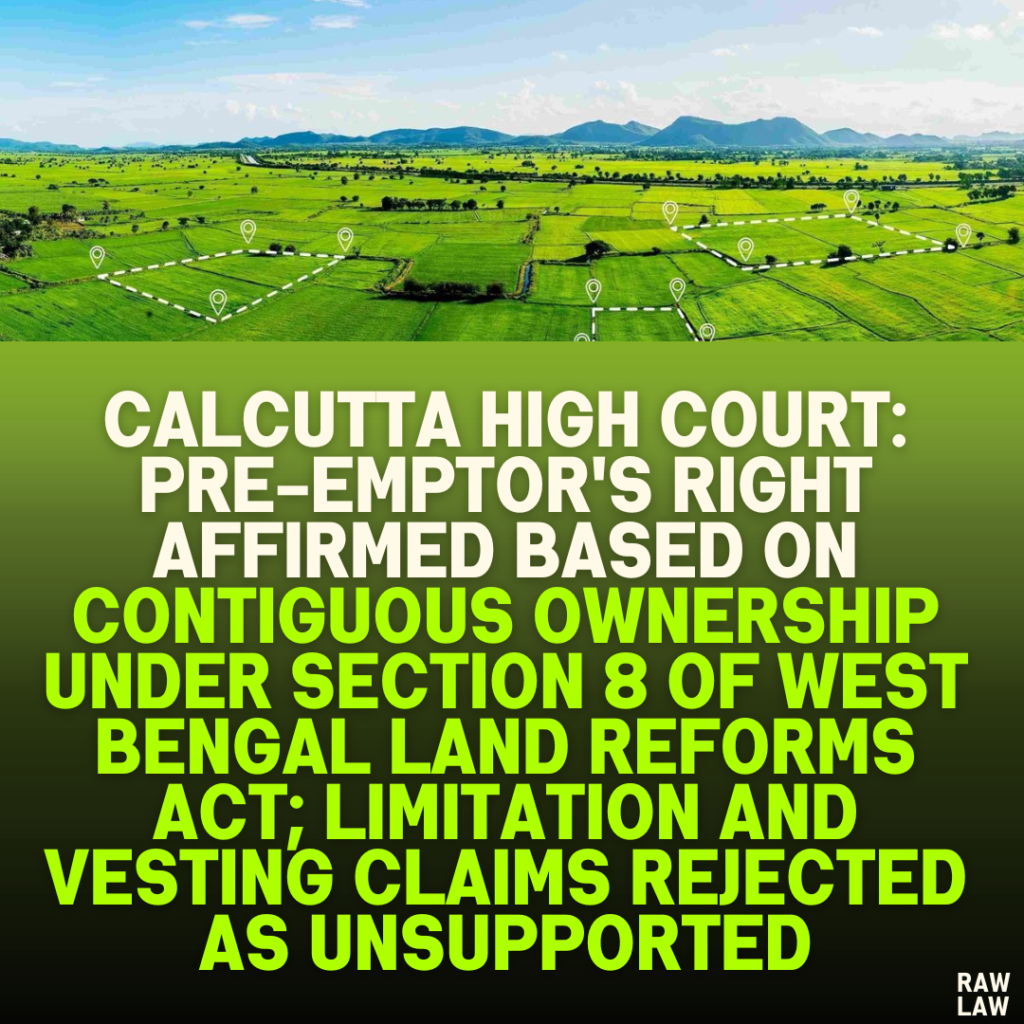Court’s Decision
The Calcutta High Court dismissed a revision application challenging the trial and appellate courts’ orders, which upheld a pre-emption application filed under Section 8 of the West Bengal Land Reforms Act, 1955. The Court ruled that the pre-emptor was entitled to pre-emption based on contiguous ownership of the suit property and that claims regarding the land being vested with the State lacked evidence.
Facts
- The suit property originally belonged to Kumar Krishna Nandi Chowdhury, who transferred it through a registered patta in 1943 to Narayan Chandra Baidya.
- Baidya gifted 72 decimals of land to his son, Chittaranjan Baidya, in 1967.
- Chittaranjan subsequently sold 6 decimals to the pre-emptor and 4 decimals to another party.
- Legal heirs of Chittaranjan contested the State’s claim of vesting 62 decimals in Title Suit No. 43 of 1983, which culminated in a declaration of their title and possession over the land.
- In 1982, the petitioner purchased the suit property, and the pre-emptor filed a pre-emption application in 1984, claiming a right as an adjacent landowner.
Issues
- Limitation: Whether the pre-emption application was barred by limitation.
- Vesting: Whether the land owned by the pre-emptor was vested with the State.
- Contiguous Ownership: Whether the pre-emptor satisfied the statutory conditions for pre-emption.
Petitioner’s Arguments
- The application for pre-emption was time-barred since it was filed two years after the sale deed was executed.
- The land owned by the pre-emptor was vested with the State under the West Bengal Land Reforms Act, rendering their claim invalid.
- Pre-emption rights must persist through the application, decision, and decree stages; any loss of these rights voids the claim.
Respondent’s Arguments
- The pre-emption application was timely, as limitation commenced only after the deed’s registration was complete under Section 61 of the Registration Act.
- Title Suit No. 43 of 1983 established that the pre-emptor’s land was not vested with the State, and the State never took possession of the land.
- As the owner of adjacent land, the pre-emptor satisfied the statutory conditions for pre-emption.
Analysis of the Law
- Section 8, West Bengal Land Reforms Act, 1955: This section grants pre-emption rights to co-sharers and adjacent landowners. The pre-emptor’s claim was grounded on contiguous ownership.
- Section 61, Registration Act: The law states that a sale is deemed complete upon the registration of the sale deed. Thus, the limitation period for filing a pre-emption application starts from the registration date.
- Land Vesting Provisions: Under the West Bengal Land Reforms Act and its rules, vesting requires procedural compliance, including documented possession by the State. No such evidence was presented in this case.
Precedent Analysis
- Sk. Abdul Azis v. Mst. Samidanessa Bibi (1987): Pre-emption rights must exist until the decree.
- Bhagwan Das v. Chet Ram (1971): Reinforced the necessity of timely pre-emption applications.
- Amal Kumar Giri v. Nani Gopal Paira (2004): Discussed statutory limitation for filing pre-emption claims.
- Ramgati Khan v. Gobinda Chandra Khan (2005): Highlighted the importance of documented possession in claims involving vesting.
Court’s Reasoning
- Limitation: The court accepted that the pre-emption application was filed within the limitation period, as the registration date governed the limitation period, not the sale deed’s execution date.
- Vesting: The court found no evidence supporting the petitioner’s claim that the pre-emptor’s land was vested with the State. The judgment in Title Suit No. 43 of 1983 established the pre-emptor’s title and possession.
- Contiguous Ownership: The evidence presented, including the deed of sale and prior judgments, demonstrated that the pre-emptor was an adjacent landowner, entitling them to pre-emption rights under the law.
Conclusion
The High Court dismissed the revision application, affirming the lower courts’ findings that the pre-emptor had a legitimate right to pre-emption. Claims of vesting were unsupported, and the application was timely.
Implications
The ruling reinforces the criteria for pre-emption under West Bengal’s land laws, emphasizing the significance of statutory compliance in vesting claims. The judgment also clarifies the computation of limitation periods for pre-emption applications, ensuring legal certainty for litigants.
